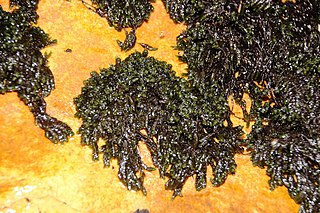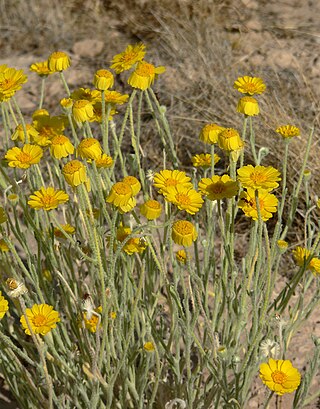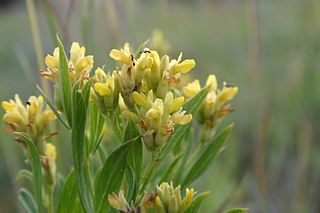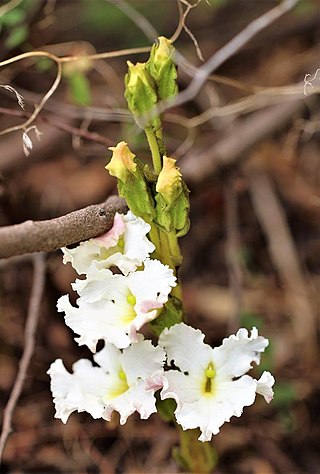
Tulbaghia is a genus of monocotyledonous herbaceous perennial bulbs native to Africa, belonging to the amaryllis family. It is one of only two known genera in the society garlic tribe within the onion subfamily. The genus was named for Ryk Tulbagh (1699–1771), one time governor of The Cape of Good Hope.

Osteospermum, is a genus of flowering plants belonging to the Calenduleae, one of the smaller tribes of the sunflower/daisy family Asteraceae. They are known as the daisybushes or African daisies. Its species have been given several common names, including African daisy, South African daisy, Cape daisy and blue-eyed daisy.

William Henry Harvey, FRS FLS was an Irish botanist and phycologist who specialised in algae.

Baileya multiradiata is a North American species of sun-loving wildflower in the family Asteraceae. It is native to the deserts of northern Mexico and the Southwestern United States. It has been found in the States of Sonora, Chihuahua, Coahuila, Durango, Aguascalientes, California, Arizona, Nevada, Utah, New Mexico, and Texas.

Mystacidium, abbreviated as Mycdm in horticultural trade, is a genus of the orchid family (Orchidaceae). It is native to eastern and southern Africa from Tanzania to South Africa.

Wardia is a monotypic genus of mosses in the subclass Dicranidae; it contains only the species Wardia hygrometrica, "an aquatic moss endemic to the Western Cape province of South Africa." It is the only endemic moss family in South Africa. As it is an aquatic moss, it was first classified in the Fontinalaceae, but molecular studies have shown that it is more closely related to the Dicranaceae.

Cotyledon tomentosa is a species of flowering plant in the family Crassulaceae, native to South Africa. It is a succulent evergreen shrub with large chunky ovate fuzzy green leaves. Its autonymous subspecies is known as the bear's paw because of the prominent "teeth" at the tips of its leaves. It forms large orange bell-shaped flowers in spring.

Baileya pleniradiata is a North American species of flowering plant in the daisy family, Asteraceae. It is known by the common name woolly desert marigold. It is native to desert regions of the southwestern United States and northern Mexico, where it grows in sandy habitats. It has been found in the States of Chihuahua, Sonora, Baja California, Arizona, Utah, and Nevada.

Pearsonia is a genus of 12 species of plants belonging to the family Fabaceae and occurring in Africa south of the equator with 1 species found on Madagascar. The species are usually herbs or shrublets with woody rootstocks. Leaves are usually sessile and 3-foliolate. The inflorescence is a congested or lax terminal raceme. The name of this genus commemorates the South African botanist Henry Harold Welch Pearson.

Harveya is a genus of parasitic plants in the family Orobanchaceae. The approximately 29 species included are native to Africa from Eritrea to South Africa, Madagascar and the Mascarene Islands, the Arabian Peninsula, and Turkmenistan in Central Asia. In South Africa they are commonly known as 'inkblom', because early settlers used the flowers to make ink, and this is the source of the English common-names for the genus of ink flower or ink plant.

Tulbaghia violacea, commonly known as society garlic, pink agapanthus, wild garlic, sweet garlic, spring bulbs, or spring flowers, is a species of flowering plant in the family Amaryllidaceae. It is indigenous to southern Africa, and reportedly naturalized in Tanzania and Mexico.

Hermannia is a genus of flowering plants in the mallow family, Malvaceae. It comprises at least 65 species with many more species as yet unresolved.

Bernard Harvey, known professionally as Harv, is an American record producer, musician and songwriter from Kansas City, Kansas and based in Los Angeles. He has produced for music industry artists such as Justin Bieber, Skrillex, Cherish, Summer Walker, Normani, Post Malone, Gucci Mane, Eminem, and Omah Lay.

Dicrastylis is a genus of plants in the Lamiaceae, first described in 1855. The entire genus is endemic to Australia. The type species is Dicrastylis fulva.

Barberetta is a genus of herbaceous perennial plants in the family Haemodoraceae. It contains only one known species, Barberetta aurea.

Felicia erigeroides, commonly known as wild Michaelmas daisy, isithelelo or ixhaphozi, is a species of flowering plant in the family Asteraceae native to South Africa, where it is found from Humansdorp to KwaZulu-Natal.
Marianne or Edda Fannin was an Irish botanical artist, known for her work painting the flora of South Africa. She was regarded as one of the principle South African botanical artists of her time.
Felicia annectens is an annual plant of up to about 25 cm (10 in) high, that is assigned to the family Asteraceae. The lower leaves are opposite and the higher leaves alternate. The bloated involucre consists of very broad, hairless bracts. These protect up to ten, short, bluish ray florets that encircle yellow, partly sterile disc florets. The heads sit individually on top of up to 6 cm long stalks. The species was considered extinct after no observations were made after 1915, but was rediscovered in the 21st century. It occurs in the Western Cape province of South Africa.
Empleuridium is a genus of flowering plants belonging to the family Celastraceae, with a single species Empleuridium juniperinum. Its native range is the Cape Provinces of South Africa.

Tulbaghia acutiloba, one of many plants named wild garlic, is a species of plant in the Allioideae subfamily of the Amaryllidaceae family. First described by William Henry Harvey in 1854, it is found in the countries of Botswana, Eswatini, Lesotho, and South Africa.
















